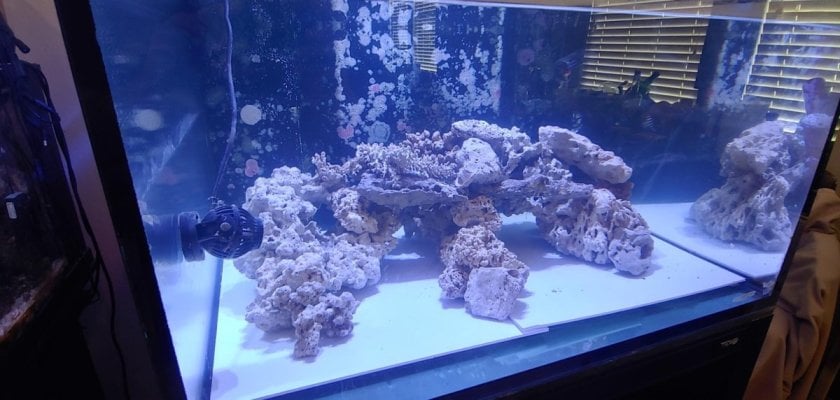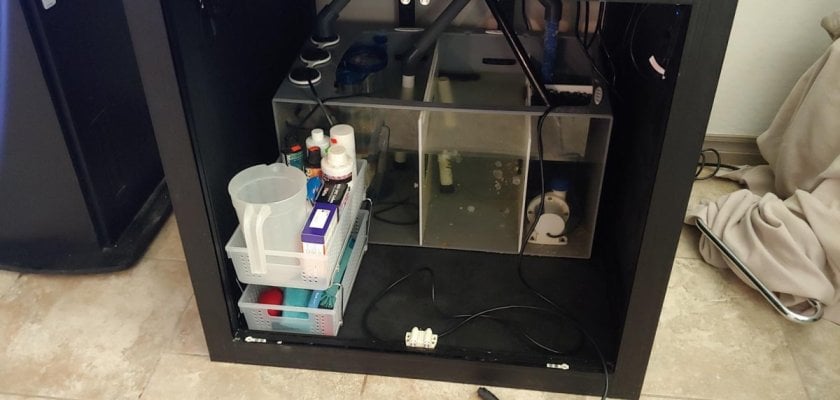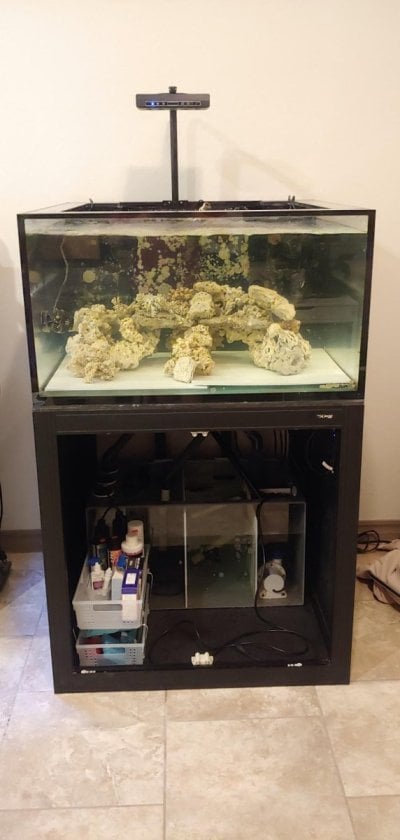Hey all,
I am setting up a new tank (112g Innovative Marine lagoon - used and running just prior to my purchase 2 weeks ago, no live stock included, just tank/sump/return pump/skimmer). Much of the rock I will be using is very old dry rock that I had in a previous tank that was removed and set aside over 10 years ago. The rock sat around in an old plastic bin in my back yard for years. The bin sorta fell apart in the AZ heat which introduced a lot of bugs into the rock. To start the cleaning process on the rocks, I soaked them in water I collected from water changes from my other 30g tank. I then scrubbed the rocks down with a nylon brush and aggressively swished the rocks around in the water to remove as much filth as possible. (All of this rock is real ocean rock from back in the day when you didn't need a lean on your house to afford it)
End goal of cycle/cook process:
-Get this rock cooked/cycled as efficiently as possible
-Add live rock from another tank at some point (I am moving 5 fish and some live rock from a 30g tank that's been operating for many years)
-Add a medium depth live-sand bed (sand is a mix of new live sand and dry sand for cost purposes - mostly live sand)
The plan:
-cook/cycle dry rock in the main tank
-process will happen on a bare bottom for easy clean up of die-off and to keep the live-sand bed clean - rock
-add bacteria to aid process
-weekly water changes (~25%)
-Wait until ammonia drops to 0
-Remove rock (keeping rock wet in a bin during process)
-Add sand bed/place rock/aqua-scape/add live rock from old tank (all in one step)
-Wait for any cycling to finish after addition of live sand and old live rock
Current status:
-Bare bottom w/ corrugated plastic sheets to protect glass bottom
-Saltwater/rock added 5 days ago (Mix of RO and RODI water per what I could obtain, there's some phosphates going in to start. RODI system coming soon)
-3 power heads running
-Lights off
-sump/return not running because I lost the return pump power-pack (replacement in mail)
-Recommended dose (for new tanks) of aquavitro "seed" added today (bacteria)
Questions:
-Should I continue to add bacteria during this cooking/cycling process per the instructions?
-Am I actually cooking/cycling at the same time, or just cooking?
-If I continue to add bacteria, should I feed that bacteria with some fish food every few days?
-Should I add in a damsel fish to aid in ammonia production at some point? If so, when?
-Per my plan, should I continue to wait until ammonia drops to 0 to add the new live sand and live rock from the other tank? Or, should I just do this asap?
The reason for the post is to lean on the collective experience of this group to complete this setup process as efficiently as possible, with as few screw-ups as possible.
Please feel free to ask any an all questions to obtain any info I may have left out. Thanks in advance for any advise.



I am setting up a new tank (112g Innovative Marine lagoon - used and running just prior to my purchase 2 weeks ago, no live stock included, just tank/sump/return pump/skimmer). Much of the rock I will be using is very old dry rock that I had in a previous tank that was removed and set aside over 10 years ago. The rock sat around in an old plastic bin in my back yard for years. The bin sorta fell apart in the AZ heat which introduced a lot of bugs into the rock. To start the cleaning process on the rocks, I soaked them in water I collected from water changes from my other 30g tank. I then scrubbed the rocks down with a nylon brush and aggressively swished the rocks around in the water to remove as much filth as possible. (All of this rock is real ocean rock from back in the day when you didn't need a lean on your house to afford it)
End goal of cycle/cook process:
-Get this rock cooked/cycled as efficiently as possible
-Add live rock from another tank at some point (I am moving 5 fish and some live rock from a 30g tank that's been operating for many years)
-Add a medium depth live-sand bed (sand is a mix of new live sand and dry sand for cost purposes - mostly live sand)
The plan:
-cook/cycle dry rock in the main tank
-process will happen on a bare bottom for easy clean up of die-off and to keep the live-sand bed clean - rock
-add bacteria to aid process
-weekly water changes (~25%)
-Wait until ammonia drops to 0
-Remove rock (keeping rock wet in a bin during process)
-Add sand bed/place rock/aqua-scape/add live rock from old tank (all in one step)
-Wait for any cycling to finish after addition of live sand and old live rock
Current status:
-Bare bottom w/ corrugated plastic sheets to protect glass bottom
-Saltwater/rock added 5 days ago (Mix of RO and RODI water per what I could obtain, there's some phosphates going in to start. RODI system coming soon)
-3 power heads running
-Lights off
-sump/return not running because I lost the return pump power-pack (replacement in mail)
-Recommended dose (for new tanks) of aquavitro "seed" added today (bacteria)
Questions:
-Should I continue to add bacteria during this cooking/cycling process per the instructions?
-Am I actually cooking/cycling at the same time, or just cooking?
-If I continue to add bacteria, should I feed that bacteria with some fish food every few days?
-Should I add in a damsel fish to aid in ammonia production at some point? If so, when?
-Per my plan, should I continue to wait until ammonia drops to 0 to add the new live sand and live rock from the other tank? Or, should I just do this asap?
The reason for the post is to lean on the collective experience of this group to complete this setup process as efficiently as possible, with as few screw-ups as possible.
Please feel free to ask any an all questions to obtain any info I may have left out. Thanks in advance for any advise.























